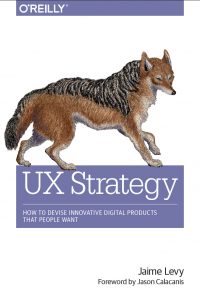 Between my recreational, science fiction reads, I like reading books to brush up on product and business development, software development techniques, management and leadership skills, and business strategy. Strangely enough (tongue in cheek), the emails I get from Amazon are either full of sci-fi books or business books. Therefore, I was not surprised when UX Strategy: How to Devise Innovative Digital Products that People Want by Jamie Levy showed up in my Amazon recommendations. Since I work with clients on product development strategies, as well as potential product ideas for my business, UX Strategy looked like it had a lot of potential. The strong reviews on Amazon certainly didn’t hurt its cause, so I added it to my short list of books for 2016.
Between my recreational, science fiction reads, I like reading books to brush up on product and business development, software development techniques, management and leadership skills, and business strategy. Strangely enough (tongue in cheek), the emails I get from Amazon are either full of sci-fi books or business books. Therefore, I was not surprised when UX Strategy: How to Devise Innovative Digital Products that People Want by Jamie Levy showed up in my Amazon recommendations. Since I work with clients on product development strategies, as well as potential product ideas for my business, UX Strategy looked like it had a lot of potential. The strong reviews on Amazon certainly didn’t hurt its cause, so I added it to my short list of books for 2016.
Tag Archives: Must Reads
Book review: The Wayward Pines Trilogy
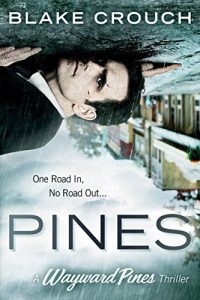 Even though I have a reading list that has grown to out of control proportions of 150+ books strong, I’m always on the lookout for book recommendation sources. I have a few friends and blogs that have become trusted sources. There’s my ever present nemesis – the infamous Amazon recommendation engine. For my latest read, I decided to try a new recommendation source – Gizmodo, one of the tech blogs that I follow. One of their must reads from a while back was Pines from the Wayward Pines trilogy by Blake Crouch. Since I follow the site primarily for tech gadget news, I was a little concerned about the potential quality of their book recommendations, but I figured it was worth at least a shot.
Even though I have a reading list that has grown to out of control proportions of 150+ books strong, I’m always on the lookout for book recommendation sources. I have a few friends and blogs that have become trusted sources. There’s my ever present nemesis – the infamous Amazon recommendation engine. For my latest read, I decided to try a new recommendation source – Gizmodo, one of the tech blogs that I follow. One of their must reads from a while back was Pines from the Wayward Pines trilogy by Blake Crouch. Since I follow the site primarily for tech gadget news, I was a little concerned about the potential quality of their book recommendations, but I figured it was worth at least a shot.
Book Review: High Output Management
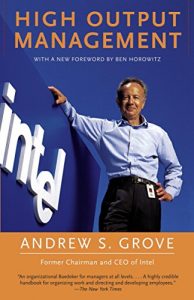 Given how often management theories change and evolve, there are very few “classic” management books. High Output Management by Andrew S. Grove qualifies as one. For those who are unfamiliar with Andrew (Andy) Grove, he was one of the founders of Intel Corporation, became its CEO in 1987, and served as Chairman of the Board from 1997-2005. He was an instrumental figure in many of Intel’s business strategies, particularly the decision to change Intel’s focus from memory chips to microprocessors. In other words, Andy Grove is synonymous with Intel. Even today, a lot of the business practices, strategies, and culture of Intel are a reflection of his philosophies of building and running a successful company.
Given how often management theories change and evolve, there are very few “classic” management books. High Output Management by Andrew S. Grove qualifies as one. For those who are unfamiliar with Andrew (Andy) Grove, he was one of the founders of Intel Corporation, became its CEO in 1987, and served as Chairman of the Board from 1997-2005. He was an instrumental figure in many of Intel’s business strategies, particularly the decision to change Intel’s focus from memory chips to microprocessors. In other words, Andy Grove is synonymous with Intel. Even today, a lot of the business practices, strategies, and culture of Intel are a reflection of his philosophies of building and running a successful company.
Book Review: I, Robot
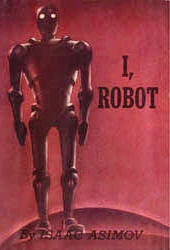 Now, look, let’s start with the three fundamental Rules of Robotics – the three rules that are built most deeply into a robot’s positronic brain.
Now, look, let’s start with the three fundamental Rules of Robotics – the three rules that are built most deeply into a robot’s positronic brain.
One, a robot may not injure a human being, or, through inaction, allow a human being to come to harm.
Two, a robot must obey the orders given it by human beings except where such orders would conflict with the First Law.
Three, a robot must protect its own existence as long as such protection does not conflict with the First or Second Laws.
These are Isaac Asimov’s easily recognizable and famous Three Laws of Robotics as laid out in his collection of short stories – I, Robot. For science fiction aficionados, these are easily identified and, most likely, committed to memory. Unfortunately for me, I just recently learned these laws. Sure, I’d heard them paraphrased many times and referenced in numerous books, but I never knew the true context in which they were used by Asimov. Now that I know the context, the rules are even more poignant and relevant in my mind.
Book review – Grain Brain
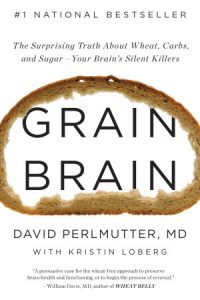 When I told Steve Hudson, a good friend of mine, that I was going to read Wheat Belly, he strongly suggested that I also read Grain Brain by Dr. David Perlmutter, too. He said that I might even like it better.
When I told Steve Hudson, a good friend of mine, that I was going to read Wheat Belly, he strongly suggested that I also read Grain Brain by Dr. David Perlmutter, too. He said that I might even like it better.
Grain Brain explores the question “what if everything we’ve been told about diet and nutrition has been wrong?” It’s definitely an interesting perspective on things. If you look at what’s happened over the last 25 years since low fat, high carb diets with lots of whole grains has been promoted as the healthy way to eat, the results have not been stellar. Obesity has reached epidemic proportions and illnesses such as Type 2 diabetes has increased considerably. According to statistics cited in the book, diabetes cases among Americans doubled between 1997 and 2007 and continue to rise. And diabetes is just the tip of the iceberg. Dr. Perlmutter shows how the effects of grains and carbohydrates also contributes to brain related maladies like Alzheimer’s and dimentia, which have also been on the rise recently.
While I may not agree with 100% of the theories cited in the book, here are a few of the key takeaways that I got from the book and have incorporated into my daily eating habits.
Book review – Wheat Belly
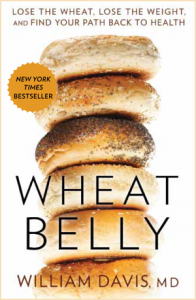 When a good friend of yours recommends a book, you add it to your reading list. When two friends recommend the same book, you move it to the top. Such was the case with Wheat Belly by Dr. William Davis. Both Bob Nunn and Steve Hudson, two friends of mine who don’t know each other, independently recommended the book to me. It took a little longer that I would have liked to get around to reading it, but I decided to make it a priority in 2016. Seeing the benefits of cutting sugar out of my diet throughout 2015, I wanted to read a couple of nutritional books in 2016 to see if there were any additional tweaks I should be making to my eating habits.
When a good friend of yours recommends a book, you add it to your reading list. When two friends recommend the same book, you move it to the top. Such was the case with Wheat Belly by Dr. William Davis. Both Bob Nunn and Steve Hudson, two friends of mine who don’t know each other, independently recommended the book to me. It took a little longer that I would have liked to get around to reading it, but I decided to make it a priority in 2016. Seeing the benefits of cutting sugar out of my diet throughout 2015, I wanted to read a couple of nutritional books in 2016 to see if there were any additional tweaks I should be making to my eating habits.
Book review: Beacon 23
![]() Make no mistake about it, I’m a big fan of Hugh Howey’s writing. I was captivated by the Silo Series and made the mistake of reading it while he was writing it. After reading Wool and Shift, it was a long painful wait for Dust to become available.
Make no mistake about it, I’m a big fan of Hugh Howey’s writing. I was captivated by the Silo Series and made the mistake of reading it while he was writing it. After reading Wool and Shift, it was a long painful wait for Dust to become available.
My next Hugh Howey adventure was Sand, which I had low expectations for. I mean, how could a story about people living in dirt be interesting? Somehow, he made it captivating.
When I saw that Howey released Beacon 23, something told me that I had to pick it up. To paraphrase the Amazon description, Beacon 23 is about the operator of a space beacon in the 23rd century. These space beacons are analogous to lighthouses, and a network of them has been placed in space to allow ships to travel across the Milky Way at many times the speed of light. This far in the future, you would think that the beacons would be autonomous. Turns out they need human intervention to make sure they stay operational.
Like Sand, you would think a story about a solitary beacon operator stranded in space would be as exciting as watching grass grow. But in typical Hugh Howey fashion, he spins a yarn that connects you to the main character and describes the environment is such vivid detail that you feel like you are on the beacon with him. It keeps you entertained and on the edge of your seat.
Book review: The Rosie Project
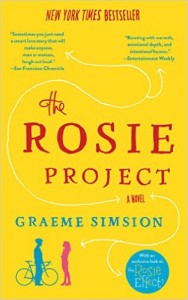 I’m always on the lookout for books to add to my reading list, even though it continues to grow faster than my reading pace. Case in point – near the end of 2014, I saw a post on one of my favorite tech blogs Gizmodo titled “Bill Gates’ favorite books of 2014 are the smart gifts for the holidays“. The top book on his list was The Rosie Effect, which was the Graeme Simsion’s sequel to The Rosie Project. It didn’t neatly fit into one of my typical reading genres of science fiction or business biographies, but being it was at the top of Gates’ best books for 2014, I figured it must be decent, so I added it to my reading list. Well, it took over a year, but The Rosie Effect finally made it to the top of the queue. Since I don’t like starting with the sequel, I figured I should start out by reading The Rosie Project first. Quite honestly, despite being highly recommended, I don’t personally know Bill Gates, so I wasn’t sure what to expect.
I’m always on the lookout for books to add to my reading list, even though it continues to grow faster than my reading pace. Case in point – near the end of 2014, I saw a post on one of my favorite tech blogs Gizmodo titled “Bill Gates’ favorite books of 2014 are the smart gifts for the holidays“. The top book on his list was The Rosie Effect, which was the Graeme Simsion’s sequel to The Rosie Project. It didn’t neatly fit into one of my typical reading genres of science fiction or business biographies, but being it was at the top of Gates’ best books for 2014, I figured it must be decent, so I added it to my reading list. Well, it took over a year, but The Rosie Effect finally made it to the top of the queue. Since I don’t like starting with the sequel, I figured I should start out by reading The Rosie Project first. Quite honestly, despite being highly recommended, I don’t personally know Bill Gates, so I wasn’t sure what to expect.
Books to read in 2016
I set an ambitious reading goal for 2015. I wanted to read 35 books, 33 of which were supposed to come from this list. I managed to read 25 books for the year, which was down from the 27 I read in 2014. Of the 25 I read last year, 17 came from my list, and 8 jumped the queue. For some reason, 8 seems to be the magic number as that was the same number that jumped the queue in 2014.
Even though I didn’t make my goal of 35, it was still a good year for reading. I focused my reading on authors that I like, recommendations from trusted sources (of the human variety), and a mix of primarily science fiction and business. I did my best to stay away from book series and trilogies, and focused my business reading on story-based biography books.
Here are the best books I read in 2015, which you may want to use to seed your 2016 reading list. As I did last year, I’ve broken the list into three categories: general recommendations, business books, and those I found entertaining which didn’t make my Must Reads list.
Book review: Uncommon Stock
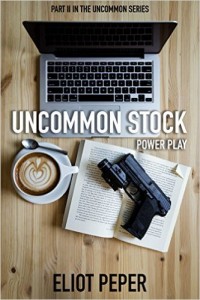 I’ve grown tired of the trilogy. I really have. I wish authors would write one book that is a complete story, or just publish the three books as one tome. I’m not a fan of drawing a story out into three books, and I don’t get the rationale behind it. Then again, I’m not an author, so what do I know?
I’ve grown tired of the trilogy. I really have. I wish authors would write one book that is a complete story, or just publish the three books as one tome. I’m not a fan of drawing a story out into three books, and I don’t get the rationale behind it. Then again, I’m not an author, so what do I know?
There are exceptions, however, and the Uncommon Stock series by Eliot Peper is one of them. After reading Uncommon Stock 1.0, the book was good enough that I decided to venture into Uncommon Stock: Power Play, which then drew me into Uncommon Stock: Exit Strategy.
